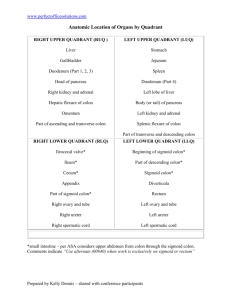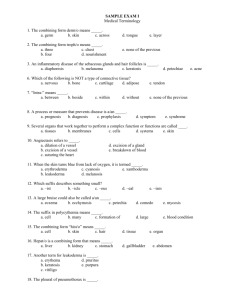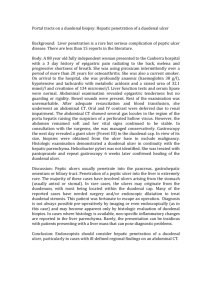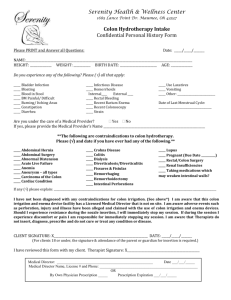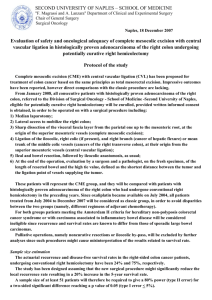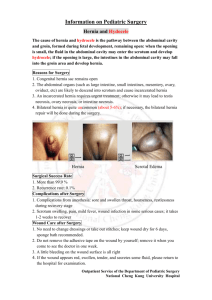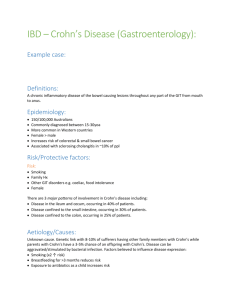MCQ`s With KEY SURGERY
advertisement
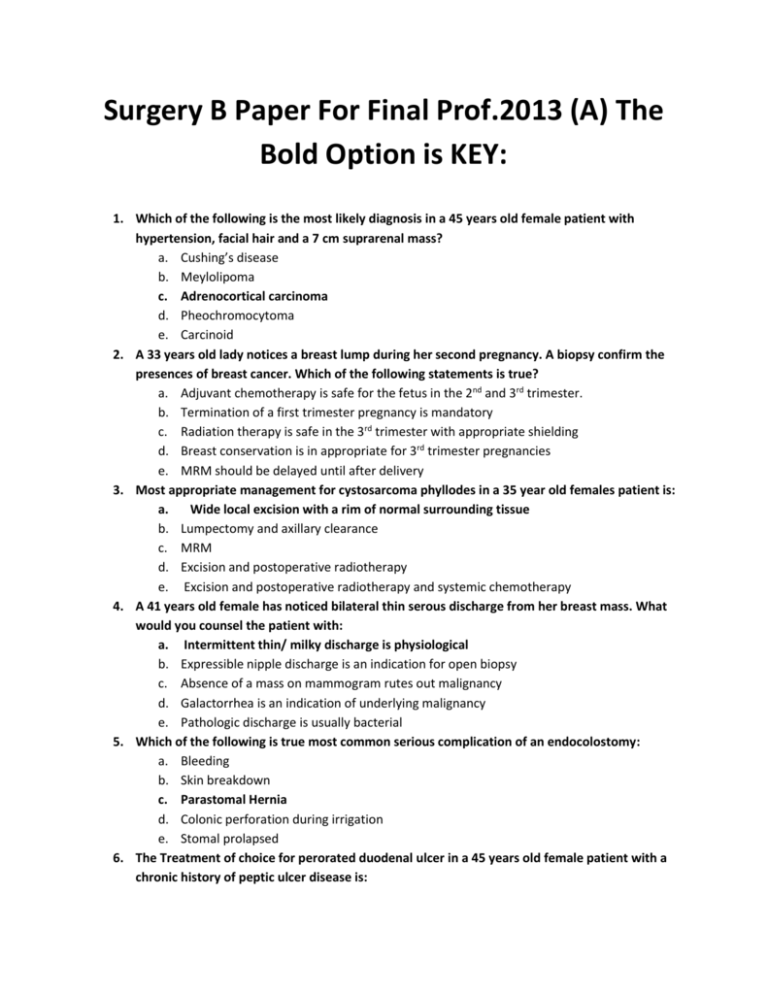
Surgery B Paper For Final Prof.2013 (A) The Bold Option is KEY: 1. Which of the following is the most likely diagnosis in a 45 years old female patient with hypertension, facial hair and a 7 cm suprarenal mass? a. Cushing’s disease b. Meylolipoma c. Adrenocortical carcinoma d. Pheochromocytoma e. Carcinoid 2. A 33 years old lady notices a breast lump during her second pregnancy. A biopsy confirm the presences of breast cancer. Which of the following statements is true? a. Adjuvant chemotherapy is safe for the fetus in the 2nd and 3rd trimester. b. Termination of a first trimester pregnancy is mandatory c. Radiation therapy is safe in the 3rd trimester with appropriate shielding d. Breast conservation is in appropriate for 3rd trimester pregnancies e. MRM should be delayed until after delivery 3. Most appropriate management for cystosarcoma phyllodes in a 35 year old females patient is: a. Wide local excision with a rim of normal surrounding tissue b. Lumpectomy and axillary clearance c. MRM d. Excision and postoperative radiotherapy e. Excision and postoperative radiotherapy and systemic chemotherapy 4. A 41 years old female has noticed bilateral thin serous discharge from her breast mass. What would you counsel the patient with: a. Intermittent thin/ milky discharge is physiological b. Expressible nipple discharge is an indication for open biopsy c. Absence of a mass on mammogram rutes out malignancy d. Galactorrhea is an indication of underlying malignancy e. Pathologic discharge is usually bacterial 5. Which of the following is true most common serious complication of an endocolostomy: a. Bleeding b. Skin breakdown c. Parastomal Hernia d. Colonic perforation during irrigation e. Stomal prolapsed 6. The Treatment of choice for perorated duodenal ulcer in a 45 years old female patient with a chronic history of peptic ulcer disease is: a. b. c. d. e. 7. A neonate presents with abdominal distension and bilious vomiting, which of the following is likely diagnosis: a. b. c. d. e. 8. 9. 10. 11. 12. Simple closure with omental patch Truncal vagotomy and pyloroplasty Antractomy and truncal vagotomy Highly selective vagotomy Partial gastrectomy Congenital hypertrophic pyloric stenosis Malrotation Intasuscepation Hirschsprnong disease Ileal atersia The following is a feature of hirschspsung disease: a. More common in females b. Associated with Klenifelter’s syndrome in 10% of cases c. Familial tendency d. Demonstrable chromosomal defect e. Not associated with Complication A blind loop inclining the upper small lower chiefly causes a defect in the absorption of: a. Carbohydrates b. Protein c. Fats d. Vitamins e. Trace elements .Which is Not True regarding meckels’s divertraulum: a. It represents the patient vitcllointesterial duct b. It carries its own blood supply c. It is typically two inches long and 2 inches from the ileoceal d. It is presents in about 2% of the population Saint’s triad does not include: a. Hiatus hernia b. Colonic diverticule c. Gall stones d. Peptic ulcer Which of the following is true for ulcerative colitis: a. More common in persons with servere emotional distress b. Inherited as an antosomal dominant disease c. Strong correlation with the presences of H. Pylori d. Smoking does not worsen its symptoms 13. Ileocecal TB with obstruction is treated by: a. NSAIDS b. Steroid c. ATT d. Ileocecal Resection 14. The drug that is most useful in the treatment of carcinoid syndrome: a. Somaltotion b. Octreotide c. Tamoxiferin d. NSAIDS e. Loperamide 15. The most common site for colorectal carcinoma is: a. Sigmoid b. Caecum c. Rectum d. Ascending colon e. Descending colon 16. A 65 years old man presents with feature of large bowel obstruction. He is most likely to have: a. Ileocaecal TB b. Annular ca Right colon c. Annular Ca L colon d. Cauliflower lesion in rectum 17. The most common usual cause of colostomy diarrhea is: a. Stoma made too close to ileum within the ileum itself b. Excessive fluid intake by patients c. Infective enteritis d. Stasis and bacterial overgrowth proximal to an ostomy obstruction 18. A patient with severe ulcerative colitis develops severe pain abdomen , which of the following is most likely: a. Toxic dilatation b. Stricture c. Malignancy d. Scherer hemorrhage e. Peptic ulcer 19. The most common site or lipoma in the gut is: a. Rectum b. Sigmoid colon c. Ascending colon d. Caecum e. Transverse colon 20. Skin excoriation is most marked in: a. Pancreatic fistulae b. Duodenal fistulae c. Distal ileal fistulae d. Colonic fistulae 21. Which of the following is least likely to occur as a complication of colostomy: a. Bleeding b. Prolapse c. Parastomal hernia d. Colostomy volvulus 22. Which of the following factor least contributes to formation of adhesion after surgery: a. Excessive blood loss b. Excessive bowel contact with gauze c. Raw peritoneal surfaces d. Nature of bowel pathology 23. Double stomach appearance on plain radiograph of abdomen is typical a feature of: a. Congenital hyper tapeline pyloric stenosis b. Duodenal Artesia c. Combined duodenal and jejuna Artesia d. Midgut volvulus 24. The gaseous distribution proximal to a site of intestinal obstruction is constituted primarily of: a. Hydrogen sulpluide b. Nitrogen c. Co2 d. Mixture of hydrocarbons 25. Absolute constipation is most likely to occur in: a. Fecal impaction b. Richter’s hernia c. Obstructed enterocele d. Vascular occlusion 26. All of the following are true regarding management in acute appendicitis EXCEPT. a. Abdominal ultrasound has poor diagnostic accuracy. b. Appendectomy is the treatment of choice. c. Chsner-sherren regimen is the standard conservative regimen d. Laparoscopy has value as a diagnosis tool 27. A fistula in Ano is termed high or low with reference to: a. Anal verge b. Anorectal ring c. Dentate line d. Cuboidal epithelium of anal canal. 28. All are factures of pilonidal sinus except. a. It is usually acquired in origin. b. Other than the sinus over distal coccyx, the most common site for pilonidal sinus is unterdigital . c. Recurrences are extremely rare once excision of the tract is carried out d. The sinus tract ends blindly near the sacrum 29. The most common bacterial growth on pus C/S from a perianal abscises is: a. Streptococcus fecalis b. E.coli c. Staplialococeus anreus d. A mixed growth of bacteroides, protons and streptococcal species 30. A 50yrs old lady presents with a painless irreducible 2cm. umbilical hernia she is likely to have. a. Omentocele b. Enterocele c. Bitters hernia d. Extraperitoneal fat in hernial sec. 31. A 20yrs old female patient presents with hematuria while of the following is LEAST likely to reveal the diagnosis? a. b. c. d. Urine cytology X-ray KUB U/S abdomen and pelvis NO 32. A patient is said to have a significant urinary infection if the number of bacteria /ml of urine is at least: a. b. c. d. e. 102 104 107 1010 105 33. What percentage of renal function must be lost before renal failure becomes eminent? a. b. c. d. e. 10_15% 20_25% 40_50% 66_75% Over 90% 34. A patient has typical rend colic. The renal calculi is seen on US but not on X-ray. Which of the following stones is most likely? a. Uric acid b. Cysteine c. Oxalate d. Triple phosphate 35. Which of the following parts of urinary tract is least accessible for US: a. b. c. d. e. Upper pole of kidney Lower pole of kidney lower ureter lower bladder mid ureter 36. A young man sustain blow on the loin and presents with hematuria. Which of the following does the patient LEAST require: a. b. c. d. Immediate US Immediate NU Immediate CT scan Immediate surgery 37. Staghorn calculi are usually: a. b. c. d. Oxalate Phosphate Urate/uric acid Cysteine 38. A 26 yrs old man is diagnosed to have a 3mm stone is the upper calyx of right kidney. The treatment option should be: a. b. c. d. PCN ESWL Conservative treatment with plenty of fluid intake Open pyelolithotomy 39. A young man sustains a lower abdominal injury. Which of the following is most likely to confirm the diagnosis? a. b. c. d. IVP Peritoneal tap CT scan Cystogram 40. Which of the following are least likely to develop bladder cancer? a. Textile workers b. Radio therapists c. Tyre,rubber,cable workers d. Leather workers 41. Bladder involvement in TB is most often derived from: a. b. c. d. Distant focus by a blood borne infection Lympliatic spread Direct spread from ileocecal TB Renal lesion 42. BPH mostly arises from which zone: a. b. c. d. Peripheral zone central zone Periurethral transitional zone Anterior zone 43. Skeletal metastasis from prostate cancer occur most frequently to: a. b. c. d. Dorsal vertebrae Femur head Pelvic bone Skill 44. Which organisms require the highest temperature for motivation: a. b. c. d. Vegetative form of E-histolztra Mycobacterium TB HIV Clostridium tetani. 45. Overdose of local anesthesia typically causes: a. b. c. d. Depressed consciousness circumoral Paraesthesia Vomiting/hypertension Extrapyramidal symptoms, respiratory depression. Perspiration, sin king sensation dictated pupils

